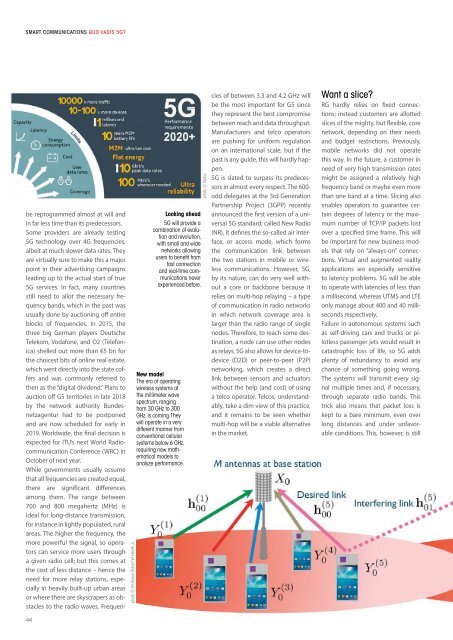Smart Industry 2/2018
Smart Industry 2/2018 - The IoT Business Magazine - powered by Avnet Silica
Smart Industry 2/2018 - The IoT Business Magazine - powered by Avnet Silica
Create successful ePaper yourself
Turn your PDF publications into a flip-book with our unique Google optimized e-Paper software.
<strong>Smart</strong> Communications Quo vadis 5G?<br />
44<br />
photo ©: Professor Robert W. Heath Jr.<br />
Looking ahead<br />
5G will provide a<br />
combination of evolution<br />
and revolution,<br />
with small and wide<br />
networks allowing<br />
users to benefit from<br />
fast connection<br />
and real-time communications<br />
never<br />
experienced before.<br />
New model<br />
The era of operating<br />
wireless systems at<br />
the millimeter wave<br />
spectrum, ranging<br />
from 30 GHz to 300<br />
GHz, is coming. They<br />
will operate in a very<br />
different manner from<br />
conventional cellular<br />
systems below 6 GHz,<br />
requiring new mathematical<br />
models to<br />
analyze performance.<br />
photo ©: Nokia<br />
be reprogrammed almost at will and<br />
in far less time than its predecessors.<br />
Some providers are already testing<br />
5G technology over 4G frequencies,<br />
albeit at much slower data rates. They<br />
are virtually sure to make this a major<br />
point in their advertising campaigns<br />
leading up to the actual start of true<br />
5G services. In fact, many countries<br />
still need to allot the necessary frequency<br />
bands, which in the past was<br />
usually done by auctioning off entire<br />
blocks of frequencies. In 2015, the<br />
three big German players Deutsche<br />
Telekom, Vodafone, and O2 (Telefonica)<br />
shelled out more than €5 bn for<br />
the choicest bits of online real estate,<br />
which went directly into the state coffers<br />
and was commonly referred to<br />
then as the “digital dividend.” Plans to<br />
auction off G5 territories in late <strong>2018</strong><br />
by the network authority Bundesnetzagentur<br />
had to be postponed<br />
and are now scheduled for early in<br />
2019. Worldwide, the final decision is<br />
expected for ITU’s next World Radiocommunication<br />
Conference (WRC) in<br />
October of next year.<br />
While governments usually assume<br />
that all frequencies are created equal,<br />
there are significant differences<br />
among them. The range between<br />
700 and 800 megahertz (MHz) is<br />
ideal for long-distance transmission,<br />
for instance in lightly populated, rural<br />
areas. The higher the frequency, the<br />
more powerful the signal, so operators<br />
can service more users through<br />
a given radio cell; but this comes at<br />
the cost of less distance – hence the<br />
need for more relay stations, especially<br />
in heavily built-up urban areas<br />
or where there are skyscrapers as obstacles<br />
to the radio waves. Frequencies<br />
of between 3.3 and 4.2 GHz will<br />
be the most important for G5 since<br />
they represent the best compromise<br />
between reach and data throughput.<br />
Manufacturers and telco operators<br />
are pushing for uniform regulation<br />
on an international scale, but if the<br />
past is any guide, this will hardly happen.<br />
5G is slated to surpass its predecessors<br />
in almost every respect. The 600-<br />
odd delegates at the 3rd Generation<br />
Partnership Project (3GPP) recently<br />
announced the first version of a universal<br />
5G standard; called New Radio<br />
(NR), it defines the so-called air interface,<br />
or access mode, which forms<br />
the communication link between<br />
the two stations in mobile or wireless<br />
communications. However, 5G,<br />
by its nature, can do very well without<br />
a core or backbone because it<br />
relies on multi-hop relaying – a type<br />
of communication in radio networks<br />
in which network coverage area is<br />
larger than the radio range of single<br />
nodes. Therefore, to reach some destination,<br />
a node can use other nodes<br />
as relays. 5G also allows for device-todevice<br />
(D2D) or peer-to-peer (P2P)<br />
networking, which creates a direct<br />
link between sensors and actuators<br />
without the help (and cost) of using<br />
a telco operator. Telcos, understandably,<br />
take a dim view of this practice,<br />
and it remains to be seen whether<br />
multi-hop will be a viable alternative<br />
in the market.<br />
Want a slice?<br />
RG hardly relies on fixed connections;<br />
instead customers are allotted<br />
slices of the mighty, but flexible, core<br />
network, depending on their needs<br />
and budget restrictions. Previously,<br />
mobile networks did not operate<br />
this way. In the future, a customer in<br />
need of very high transmission rates<br />
might be assigned a relatively high<br />
frequency band or maybe even more<br />
than one band at a time. Slicing also<br />
enables operators to guarantee certain<br />
degrees of latency or the maximum<br />
number of TCP/IP packets lost<br />
over a specified time frame. This will<br />
be important for new business models<br />
that rely on “always-on” connections.<br />
Virtual and augmented reality<br />
applications are especially sensitive<br />
to latency problems. 5G will be able<br />
to operate with latencies of less than<br />
a millisecond, whereas UTMS and LTE<br />
only manage about 400 and 40 milliseconds<br />
respectively.<br />
Failure in autonomous systems such<br />
as self-driving cars and trucks or pilotless<br />
passenger jets would result in<br />
catastrophic loss of life, so 5G adds<br />
plenty of redundancy to avoid any<br />
chance of something going wrong.<br />
The systems will transmit every signal<br />
multiple times and, if necessary,<br />
through separate radio bands. This<br />
trick also means that packet loss is<br />
kept to a bare minimum, even over<br />
long distances and under unfavorable<br />
conditions. This, however, is still
















